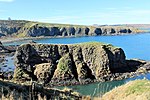Fowlsheugh

Fowlsheugh is a coastal nature reserve in Kincardineshire, northeast Scotland, known for its 70-metre-high (230 ft) cliff formations and habitat supporting prolific seabird nesting colonies. Designated as a Site of Special Scientific Interest (SSSI) by Scottish Natural Heritage, the property is owned by the Royal Society for the Protection of Birds. Fowlsheugh can be accessed by a public clifftop trail, or by boats which usually emanate from the nearby harbour at the town of Stonehaven. Tens of thousands of pelagic birds return to the site every spring to breed, after wintering at sea or in more southern climates, principal species being puffins, razorbills, kittiwakes, fulmars and guillemots. Due to global warming, the planktonic species previously present that prefer cold water are not available in the quantity required to support the historically large sandeel population. Added to the problem has been overfishing of the Scottish sandeel, further reducing the numbers of this dietary staple for puffins and other local seabirds.
Excerpt from the Wikipedia article Fowlsheugh (License: CC BY-SA 3.0, Authors, Images).Fowlsheugh
A92,
Geographical coordinates (GPS) Address Nearby Places Show on map
Geographical coordinates (GPS)
| Latitude | Longitude |
|---|---|
| N 56.9125 ° | E -2.195833 ° |
Address
A92
AB39 2TN
Scotland, United Kingdom
Open on Google Maps







